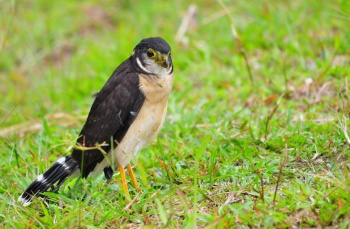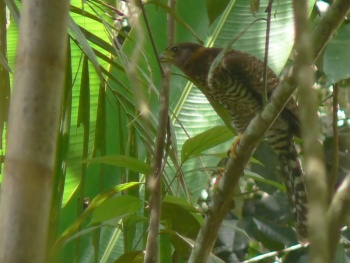- Micrastur semitorquatus
Identification
18-24" (46–58 cm)
Long-tailed; largest of the genus.
Lores and cere dull green.
Three morphs exist in the adult plumage: Whitish (where underparts and collar are whitish), tawny (where underparts and collar are tawny) and the rare dark morph (where entire plumage is black, though sometimes with faint white barring to the lower underparts).
Similar Species
A thread discussing differences between Bicolored Hawk and Collared Forest Falcon is found [here]
Distribution
Central and South America: breeds in Mexico from Sinaloa and Tamaulipas southwards and south through Central America to Panama. In South America from Colombia, Venezuela, and the Guianas south to Bolivia and northern Argentina.
Resident. Generally fairly common, but as with all Forest Falcons it is inconspicuos except for its loud voice.
Taxonomy
Subspecies
Two subspecies are recognised[1]:
- M. s. naso:
- M. s. semitorquatus:
- Rainforests of northern South America to Brazil and northern Argentina
Habitat
Rainforest, cloud forest, and forest edge and secondary-growth woodland from lowlands up to 1,500m. Also occurs in mangrove swamps.
Behaviour
Diet
Their main diet consists of mammals and quite large birds, such as chacalacas and cock-of-the-rock.
Breeding
They have been observed nesting in cliff holes.
References
- Clements, J. F., T. S. Schulenberg, M. J. Iliff, D. Roberson, T. A. Fredericks, B. L. Sullivan, and C. L. Wood. 2016. The eBird/Clements checklist of birds of the world: v2016, with updates to August 2016. Downloaded from http://www.birds.cornell.edu/clementschecklist/download/
- The Neotropical Ornithological Society
- Handbook of the Birds of the World Alive (retrieved February 2017)
Recommended Citation
- BirdForum Opus contributors. (2024) Collared Forest Falcon. In: BirdForum, the forum for wild birds and birding. Retrieved 9 November 2024 from https://www.birdforum.net/opus/Collared_Forest_Falcon
External Links
GSearch checked for 2020 platform.1






